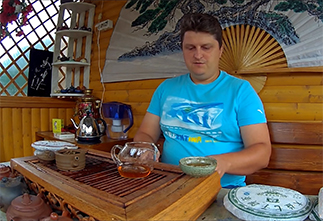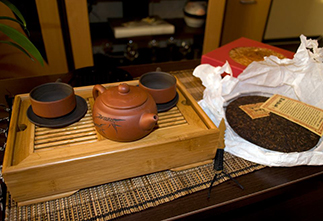Banzhang Longzhu (班章龙珠): Shu Pu'er from Kaishunhao in dragon pearl format
In the world of Chinese pu-erh tea, names often carry deep meaning, indicating origin, quality, or form. Bān zhāng lóngzhū Shu Pu-erh (班章龙珠, Bān zhāng lóngzhū) from the producer Kaishunhao (开顺号, Kāi shùn hào) is a prime example. It combines the prestigious name of the legendary tea region of Banzhang, the classic profile of heap-fermented shu pu-erh, and the convenient form of Longzhu (dragon pearl) pressing. Kaishunhao presents this product as aimed at pu-erh connoisseurs seeking both the quality associated with a famous terroir and the ease of brewing.
The Legendary Banzhang (班章, Bān zhāng )
Banzhang is the name of a village and the surrounding mountainous area in Menghai County, Yunnan Province. The region is considered one of the most prestigious and expensive sources of pu'er tea. Teas from Banzhang, especially sheng pu'er, are renowned for their power, complexity, distinctive bitterness, and quick, sweet finish (huigan). The use of the name "Banzhang" for shu pu'er implies that the high-quality tea from this renowned region was used to produce it. Although the fermentation process of shu pu'er (vodui) significantly alters the original character of the leaf, the use of quality Banzhang tea should give the finished shu pu'er a special density, depth, and potential for complex flavor development.
Shu Pu'er - fermentation in heaps (Wodui -渥堆, Wò duī )
This tea is a Shu Pu'er, meaning that it has undergone an accelerated post-fermentation process known as "Wò duī" (渥堆, Wò duī) - wet heap fermentation. It is this technique, as indicated by the "heap" that gives Shu Pu'er its characteristic features:
- Dark, almost black color of dry leaf and infusion.
- Smooth, soft, enveloping taste without harsh bitterness.
- Deep, often earthy, woody, nutty or sweet aroma.
Longzhu format (龙珠, Lóngzhū ) – “Dragon Pearl” 5 grams each
The distinctive feature of this product is the form of pressing – Longzhu (龙珠, Lóngzhū), or "Dragon Pearl". Tea leaves are carefully twisted by hand or by machine into small, dense balls. In this case, each ball weighs 5 grams, which is an ideal portion for one brew. This format is extremely convenient:
- Does not require a special knife or awl for puer.
- Easy to dose the tea leaves.
- Convenient to take with you on trips or to work.
Taste and aroma
- Aroma: Rich, deep, with a predominance of woody-nutty and sweetish date notes. Noble earthiness, without unpleasant shades.
- Taste: Very smooth, dense, oily. Dominant notes of old wood, nuts (walnut, almond), dark chocolate and cocoa. Pleasant and noticeable sweetness. Long, warming aftertaste.
Brewing recommendations
Thanks to the Longzhu format, brewing is as simple as possible:
- Take one "pearl" (5 grams).
- Place it in a gaiwan, small teapot or teapot (volume ~100-150 ml).
- Washing: Pour boiling water (95-100°C) over the ball and drain the water immediately. Repeat the washing once more for better leaf opening.
- Brewing: Pour boiling water over again and steep in short infusions. Start with 10-15 seconds, gradually increasing the time for each subsequent infusion. The tea can withstand many infusions.
Kaishunhao's Banzhang Longzhu Shu Pu'er is an intriguing combination of prestigious Banzhang raw materials, the soft and deep character of Shu Pu'er, and the exceptional convenience of the Dragon Pearl format. It is an excellent choice for those who want to experience tea associated with the legendary Banzhang terroir in an accessible and easy-to-brew form, as well as for experienced Pu'er lovers who value comfort without compromising on the quality of the raw materials.
|
Name in Chinese
|
班章龙珠 |
|
Pinyin
|
Long-term employment |
|
Translation
|
Ban Zhang Long Zhu |
|
Country
|
China |
|
Provinces
|
Yunnan (云南) |
|
Manufacturer
|
Кайшуньхао (开顺号) |
|
Fermentation method
|
In heaps |
- Комментарии
- Вконтакте
Pu-erh is one of the most unique types of tea, which only gets better with age. Many people, when they first encounter this tea, wondered: why is pu-erh more often found in pressed form (cakes, bricks, tochas), and not in loose form? The reasons for this are related to both history and the practical aspects of storing and fermenting tea. Despite modern technologies that allow the production of loose pu-erh, the shape of pressed cakes remains unchanged. And pu-erh is more often found on sale in pressed form, for example, in the form of cakes or bricks, and loose pu-erh is less common. We will talk about the reasons for pressing pu-erh into cakes in this article.
Puer is a unique Chinese tea that is distinguished by its depth of taste, complexity of aromas and versatility of aftertaste. Its taste characteristics are formed under the influence of many factors, from growing conditions to the brewing method. Let's look at the main ones.
The question often arises: how to brew puerh correctly? Sometimes the phrase "to get high" is added to it. Moreover, everyone has their own understanding of this phrase. Some mean vigor, and some - intoxication. So how to brew puerh tea correctly? Let's consider several options.
Traveling through the tea mountains, we found ourselves in another land of blue roofs - the village of Zhongcai, which is located in the Menghai district of Yunnan province. According to tradition, we were shown another local tea tree, which, according to the Chinese, is at least a million years old :) The village is very authentic, not designed for tourists, there are many wild pu-erhs there and, of course, we were warmly received. They treated us to local cuisine and tea. We also asked the residents about the prices of tea and how they have changed in recent years.
The tea ceremony occupies a special place in the centuries-old Eastern tradition. And although the essence of this phenomenon remains constant, the nature and external manifestations of the tea ceremony in different nations have their own national characteristics. In each Chinese province, the tea ceremony and the tea used in it are varied: for example, residents of the southern provinces prefer green tea, and residents of the northern provinces - red tea, in Fujian province they more often use Oolong tea, and in Yunnan province Puer tea is widely known.

























































































